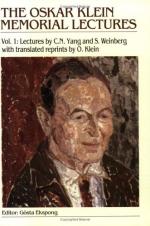|
This section contains 320 words (approx. 2 pages at 300 words per page) |
World of Physics on Oskar Klein
Oskar Klein, one of the most prominent of Swedish physicists, was born in Stockholm in 1894. At the age of 16, he started working in the laboratory of Svante Arrhenius, and published his first scientific paper the next year. Throughout his life, he worked to investigate the ways in which scientific theories are displayed in physical experience.
Using, the concept of a fourth space dimension, in addition to the three familiar space dimensions and the dimension of time, Klein formulated a theory, in 1927, that merged Maxwell's theories of electromagnetism and Einstein's theory of gravitation. This theory, known as the Kaluza-Klein Theory (it was developed independently by Theodor Kaluza), developed the concept of multiple undetected spatial dimensions. This concept is the foundation for string theories. Klein developed several other concepts key to modern physics. The Klein-Gordon equation is a relativistic counterpart to Schrdinger's equation. The Klein-Nishina formula shows the probability of different scattering angles after collisions between photons and electrons.
In 1954, Klein proposed the metalgalactic model of the universe, an alternative to the big bang theory. Klein suggested that the part of the universe that we can observe is not necessarily representative of the universe as a whole. The metagalaxy, our part of the universe, was formed from a thin gas cloud that, much more than 10 billion years ago, contracted and then reversed its motion due to radiation pressure. It is now in the process of expanding. Later, Klein proposed that the origin of the metagalaxy was a matter-antimatter annihilation.
Oskar Klein began working as an assistant to Niels Bohr in Copenhagen in 1918, remaining at Bohr's institute until 1931, receiving a position as reader in theoretical physics in 1928. During the two-year period from 1923-25, he left Copenhagen for an appointment as an instructor and then assistant professor at the University of Michigan. In 1930, Klein was appointed as a full professor of physics at Stockholm University where he remained until his retirement in 1962.
|
This section contains 320 words (approx. 2 pages at 300 words per page) |


